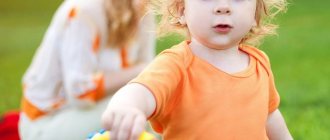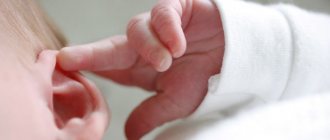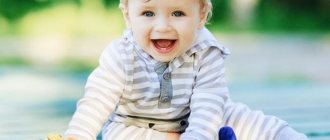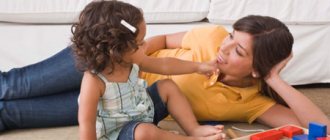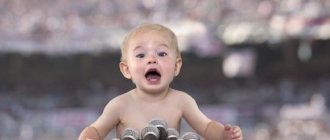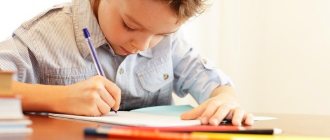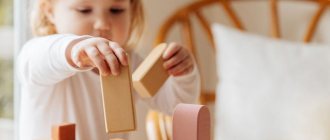More and more often, mothers complain that their child has “mess in his mouth” and it is very difficult to understand what he is saying. Non-speech hearing is one of the first factors influencing the baby’s speech and development. First, children catch and differentiate simple sounds from the surrounding world - knocking, creaking, noise, cat meowing, music, car horn. And only then does it become possible to distinguish more complex sounds - phonemes (components of the native language). Auditory perception actively develops from infancy, and the most important task of parents is to ensure that everything goes as usual. In case of deviations from the norm, the child should be helped to develop non-speech hearing through play exercises.
Spatial hearing, speech and non-speech hearing
Hearing is a rather complex system. The ears pick up elastic waves of vibrations in the environment and transmit them to the brain, which analyzes, remembers, and distinguishes different sounds. In other words, we listen with our ears and hear with our brains. Hearing is closely related to speech, the ability to reproduce certain sounds, and move to the beat of music.
- Spatial hearing. The auditory system provides orientation in space. By determining the direction of the sound (near-far, top-bottom, left-right), a person moves around and avoids danger. This is especially noticeable in the blind.
The auditory system is divided into two independent subsystems. They have common mechanisms, but are carried out by different hemispheres of the brain and are responsible for certain abilities.
- Non-speech hearing allows you to distinguish everyday sounds: the opening of a door, the sound of a knife when cutting, footsteps. Thanks to him, a person hears music and sounds of nature.
- Speech hearing is responsible for the ability to hear and analyze speech sounds.
What you need to know about non-speech hearing?
Non-speech hearing is the capture and differentiation of various sounds of the surrounding world. As well as distinguishing sounds by volume, duration, height, quantity, determining the source and direction of the sound. The dominant hemisphere of the brain (in right-handed people, the right one), its temporal region, is responsible for non-speech hearing.
Stages of development
A person’s auditory perception begins to form from the moment of birth. From distinguishing primitive, loud sounds, the child gradually moves on to differentiating tonalities, phonemes and speech sounds.
The most important stage in the development of non-speech hearing occurs in the first 3 years of life:
- The newborn hears loud sounds and reacts to them with a start.
- At 1–2 months, the child tries to determine the source of the sound, turns his eyes and head towards the noise.
- At 3–4 months, the baby differentiates sounds of different quality (piano and bell), as well as homogeneous sounds of different volumes.
- At 3–6 months, the ability to distinguish intonations develops, and then to express one’s emotions using shades of voice.
- From 6 months to one year, the child perceives increasingly subtle sounds of the environment (the rustle of a bag and the rustle of paper), catches the rhythm of a word (a watch - titi, a pencil - tatatat). It distinguishes people's voices and responds to them in different ways.
- At 1 year of age, the child accumulates his ideas about objects and their sounds. He recognizes and remembers how a dog barks, how his favorite toy falls. The baby begins to understand his native speech, but all the words and phrases he hears are still not clearly defined.
- In the 2nd–3rd year of life, speech hearing is actively formed. The child differentiates different sounds in a word, the sound composition of the word. By the end of the 3rd year, he already knows all the sounds, but so far he cannot reproduce them due to the underdevelopment of the articulatory apparatus. For example, a preschooler will have no problem distinguishing falseness if an adult pronounces “calandash” instead of “pencil,” although he himself has not yet pronounced “r.”
Subsequently, non-speech and speech hearing are improved through repeated repetition and pronunciation of sounds and words. The development of hearing and speech is a two-way process. They continue to be actively honed until the age of 9-10. But even in adulthood, development does not stop. It is possible to improve auditory perception at both 20 and 30 years old. You just have to put more effort into it.
Does it need to be developed and why?
Recognition and discrimination of non-speech sounds is the first stage of speech formation. Non-speech hearing allows you to catch the rhythm of words, intonation, pitch, timbre. With its help, the child recognizes a familiar voice, navigates space and learns about the world. It helps to determine what fell and where, how far the car is traveling, what the weather is like outside the window (wind, rain). Thus, the quality of cognition of the surrounding world, speech development, interaction with other people, and safety depend on non-speech hearing. For example, with developed hearing, when crossing the road, a child will hear the noise of an approaching car in time.
The ability to focus on sound is a very important human characteristic. Without it, it is impossible to learn to listen and understand speech - the main means of communication.
From birth, a child is surrounded by a variety of sounds: the sound of rain, the meowing of a cat, car horns, music, human speech. But the auditory impressions that the baby experiences are perceived by him unconsciously. The child does not yet know how to control his hearing, sometimes he simply does not notice sounds.
In order for the baby to learn to pronounce sounds correctly, pronounce words clearly, use all the capabilities of the voice - speak expressively, change the volume and speed of speech - first he must learn to listen. To do this, you need to be able to strain your ears and focus on the sound, to catch and distinguish various sounds.
This ability does not arise by itself, even if the child has naturally acute hearing. It needs to be developed from the first years of life. It's better to do it in the game. Our goal is to introduce the baby to a variety of non-speech sounds. In addition to the interesting plot, we offer a description of some useful and entertaining games.
When teaching a child to distinguish non-speech sounds by ear, we recommend following the following sequence:
sounds of nature: the sound of wind and rain, rustling leaves, murmur of water;
sounds that objects make: the knock of a hammer, the clinking of glasses, the creaking of a door;
transport noises: car horns, the sound of train wheels, squeaking brakes, the drone of an airplane;
sounds of playing toys: rattles, whistles, rattles, squeaks;
sounds of children's musical toys: drum, tambourine, pipe, piano.
This is the first stage for the development of phonemic awareness.
Game "Tell me what you hear?"
Goal: development of auditory perception, differentiation of non-speech sounds.
Equipment: glasses (with water and empty), jars of cereals, foil, wooden and metal spoons, screen.
Description of the game: show and name objects, demonstrate their sound. Behind the screen, you perform various actions with objects (pour water, pour cereal...). The child must determine what he hears (the rustling of paper, the sound of pouring water)
Game "In the world of sounds"
Goal: development of auditory attention, differentiation of non-speech sounds.
Description of the game: invite children to close their eyes and listen to what is happening around them.
Game "Tell me what it sounds like?"
Goal: development of auditory attention, differentiation of non-speech sounds.
Equipment: toys and objects that can produce characteristic sounds: bell, tambourine, drum, pipe, rattle, rattle.
Description of the game: introduce the child to musical instruments, play them, invite the child to play. Then invite your child to close his eyes and determine what musical instrument he plays.
Game "Find a Pair"
Goal: development of auditory attention, differentiation of non-speech sounds.
Equipment: three pairs of identical photographic film boxes with different fillings (one teaspoon each of semolina, buckwheat, peas).
Description of the game: place three boxes with different fillings in front of you and in front of your child. Take turns rattling your boxes, placing boxes in pairs that rattle equally. Then mix the boxes and ask the child to find boxes that rattle the same way.
Game "Put in order"
Goal: development of auditory attention, memory, differentiation of non-speech sounds.
Equipment: screen, musical instruments (from 2 to 5), pictures of these instruments.
Description of the game: show musical instruments, play in front of the child, ask to see a picture of this instrument. Offer your child to play on them. Introduce the rules of the game: “I will play, and you listen carefully to what the toy sounds like. Show me a picture of a sounding toy. Place the picture in front of you on the table. Listen carefully to what picture sounds after the first one. Find and put a picture with her image. Determine which toy sounds last. Find the corresponding picture." When the child learns to perform the task correctly, complicate the task by offering to arrange the instruments in the sequence of their sounds after finishing listening; increase the number of sounding instruments.
Game "Guess who's screaming."
Goal: development of auditory attention, differentiation of non-speech sounds.
Equipment: toys or pictures depicting pets familiar to the child, tape recorder, recording of animal voices.
Description of the game: an adult shows prepared pictures or toys, turning on a recording with the voices of the corresponding animals. Then he asks them to listen and guess who will come to visit them. Play a recording of animal voices, changing the order in which they are presented. The child guesses who it is.
Game "Meet guests"
Goal: development of auditory perception, differentiation of onomatopoeia.
Equipment: hats with ears of different animals.
Guests (three or four) are selected from the children, and they are given hats with ears of different animals. They go behind the screen, take turns making sounds behind the screen, and the children guess who will appear. Having gathered, the guests dance as best they can to applause. Then new guests are selected.
Game "Sun or Rain"
Goal: development of auditory attention, differentiation of non-speech sounds according to the method of reproduction.
Equipment: tambourine.
Description of the game: tell the children that the weather is good, the sun is shining, and now they will go for a walk. At this time, ring the tambourine, and the children are walking. Then say that the weather has turned bad and it is raining. Now knock on the tambourine and ask the children to run up and hide from the rain. Explain to the children that they must listen carefully to the tambourine and “walk” or “hide” in accordance with its sounds.
Game “What did Masha do?”
Goal: development of auditory perception, differentiation of non-speech sounds according to the method of reproduction.
Equipment: doll.
Game description: An adult shows a doll, says its name, and asks the children to introduce themselves. He offers to play with her. Perform actions in accordance with the text: We clap our hands - clap, clap, clap.
We stomp our feet - stomp, stomp, stomp.
We smack our lips (smack three times).
We sniffle. (sniff three times).)
Invite the children to close their eyes and guess what the doll is doing. You carry out the actions and ask each time what Masha did.
Game "It's pouring or dripping"
Goal: development of auditory perception, differentiation of non-speech sounds according to the method of reproduction.
Equipment: container with water, rubber bulb, metal basin, screen.
Game description: tell the children that it has started to rain in a fairyland. It either pours heavily (press hard on the bulb filled with water), or drips (drip water from the bulb). Behind the screen you alternate these actions, and the children say whether it is raining or dripping.
Game "Guess Who's Coming"
Goal: development of auditory perception, differentiation of non-speech sounds by sound tempo.
Equipment: pictures of a heron and a sparrow, a tambourine.
Description of the game: show pictures and explain that the heron walks importantly and slowly, and the sparrow jumps quickly. Then slowly knock on the tambourine, and the children walk like herons. When an adult quickly knocks on a tambourine, children jump like sparrows.
Game "In the clearing"
Goal: development of auditory perception, differentiation of non-speech sounds by sound tempo.
Equipment: hats with images of hares and wolves according to the number of children, drum.
Game description: divide the children into two groups: hares and wolves. Explain to the children that when you beat the drum slowly, wolves will walk in the clearing, and when you beat it quickly, hares will jump. Alternate fast and slow sounds.
Game "Rain"
Goal: development of auditory perception, differentiation of sound tempo.
Equipment: picture of rain.
Description of the game: ask to look at the picture and repeat the rhyme.
The rain dripped onto my palm: Drip - drip! (slowly)
On the flowers, on Murka - the cat: Drip - drip! (slowly)
And then he got wild. Lil and lil,
I tried my best: Drip - drip - drip - drip! (fast)
You propose to show how slowly the rain falls: hit the palm of the other with the index finger of one hand, saying: “Drip - drip!” Then you offer to show how the rain falls quickly: perform the same actions at a faster pace: “Drip - drip - drip - drip!”
Then invite the child to play echo: “Repeat like me.” Say onomatopoeia from behind the screen and ask to repeat it.
1) drip – drip-drip; 2) cap; 3) drip - drip; 4) drip - drip - drip - drip.
Game "Who's Knocking?"
Goal: development of auditory perception, differentiation of rhythmic patterns.
Equipment: illustration for the fairy tale “The Three Little Pigs”
Game description: tell the children that the pig is waiting for guests - his brothers. One pig knocks on the door like this: /- /- / (tapping the rhythm), the second like this: /-//, and the wolf knocks like this: //- /. You suggest listening carefully to the rhythm and determining who is knocking.
Game "Drops Ring"
Goal: development of auditory perception, differentiation of rhythmic patterns.
Equipment: musical triangle, picture of spring.
Description of the game: asks children to determine what time of year is shown in the picture, to name the signs of spring. Invites children to repeat spring songs. You tap out the rhythms on the musical triangle, and the child claps: /- /, / -//, //- //…
Game "Droplets"
Goal: development of auditory perception, differentiation of rhythmic patterns.
Equipment: pictures depicting rhythms in the form of drops: drop - clap your hands, dash (dash) - pause.
Description of the game: explain to your child that the droplets sing their songs based on these pictures. Show the picture and clap to the appropriate rhythm. Then ask the child to listen to the rhythm and show a picture that matches this rhythm: /-/, //, /-/-/, /-//.
Game "Quiet - Loud!"
Goal: development of auditory perception, differentiation of sounds by sound strength.
Equipment: musical instruments.
Play the chosen musical instrument either quietly or loudly. Hearing the loud sound of the instrument, the children run. Hearing a quiet sound, they walk. You can choose different instruments and offer different movement options.
Game "Walk and Run"
Goal: development of auditory perception, differentiation of sounds by sound strength.
Equipment: tambourine.
Game description: knock on the tambourine quietly, loudly and very loudly. According to the sound of the tambourine, the child performs movements: to a quiet sound he walks on his toes, to a loud sound he walks, to a very loud sound he runs.
Game "Find the toy"
Goal: development of auditory attention, differentiation of sounds by sound strength.
Equipment: small toy.
Game description: one child leaves the room. Another child hides a toy in the room. When the first child returns to the room, you explain to him that the other children will help him find the toy. When he comes close to the hidden toy, the children will clap their hands loudly. When he moves away from her, the clapping will be quieter.
How to properly develop non-speech hearing?
As mentioned above, the main stage of development of non-speech hearing occurs at the age of 0-3 years. During this period, it is important to provide the child with the opportunity to study different instruments and simply surrounding objects. Throwing toys on the floor, crumpling paper, banging on pots and plates - all this contributes to the development of auditory perception and memory. You cannot forbid your child to explore the world around him in this way. The parents’ task is to make the environment safe: provide toys and objects that are safe to break or tear, and that will not harm the baby’s health.
The development of non-speech hearing is promoted by singing, listening to music, and playing instruments. It can also be developed purposefully using game exercises. During classes, auditory perception should first be reinforced with visual images (“look, the bell is ringing”) and only then sounds should be used in isolation (“what is that ringing?”).
Games for development
The following games will help your child better navigate space, improve hearing acuity and auditory attention. They are suitable for children of different ages - 2-3 years, 4-5 and 6-7 years. For older preschoolers, tasks can be made more complicated: use more instruments, combinations of sounds.
Guess the instrument
The game develops auditory attention and teaches the child to distinguish non-speech sounds. Rules:
- An adult introduces the child to various musical instruments: drum, tambourine, pipe, rattle, xylophone. After that, he suggests playing a game where you need to close your eyes and guess what instrument just sounded. The child points the instrument with his finger and tries to play it in order to correlate the real sound with the sound in memory.
Shop
The game develops auditory perception, attention, communication skills and speech. Rules:
- An adult fills matchboxes with buckwheat, sand, coins, peas, paper clips, and cotton wool (half). He will play the role of the seller, and the child will play the role of the buyer. The child needs to buy a certain product (for example, sand) relying solely on his own hearing. Boxes can be shaken but not opened.
Long and short sound
The game develops the ability to perceive and differentiate non-speech sounds. Rules:
- The adult gives the child two cards - with a short and a long stripe drawn. The child must show the correct card, depending on the duration of the noise created by the adult. This could be playing an instrument, whistling, or simply banging a spoon on a bowl. When making noise, you need to hide behind a screen or ask the child to close his eyes.
Loud and quiet sound
The game teaches you to distinguish the pitch of non-speech sounds. Rules:
- The child is given two cards with a large and a small drum. An adult, hiding behind a screen, beats the drum with varying strength. When he knocks lightly, the child should show a picture of a small drum. And when it hits hard, you need to pick up the card with the big tool.
Hourly
Group game that develops auditory perception, non-speech hearing and spatial orientation. Rules:
- Children draw a circle in the middle of the site, and place a sentry in the center (determined by drawing lots). He is blindfolded. The remaining players quietly move across the circle to the other side of the court. The sentry needs to listen, and when he hears a rustle, command “stop!” Everyone stops, and he goes in the direction of the sound and tries to grab the intruder. If he succeeds, the one who was caught becomes the sentry; if not, the game continues.
The biggest ear
The game develops auditory attention and perception of non-speech sounds. Rules:
- The child and the adult listen to the sounds around them and take turns naming them: a car horn, a TV running, the steps of a family member, the ticking of a clock, etc. Whoever cannot name the next sound within 3 minutes loses.
Games and exercises for the development of auditory perception (non-speech and speech sounds)
Yulia Yakovleva
Games and exercises for the development of auditory perception (non-speech and speech sounds)
The ability to focus on sound (auditory attention) is an important human ability that needs to be developed. It does not arise by itself, even if the child has naturally acute hearing. It needs to be developed from the first years of life. That is why we offer games for the development of auditory attention and perception, which will teach children to concentrate, catch and distinguish a variety of sounds.
The development of auditory perception in a child of early and preschool age ensures the formation of ideas about the sound side of the surrounding world, orientation towards sound as one of the most important characteristics and properties of objects and phenomena of animate and inanimate nature. Mastery of sound characteristics contributes to the integrity of perception, which is important in the process of a child’s cognitive development.
The development of auditory perception proceeds in two directions: on the one hand, the perception of ordinary sounds (sounds of the surrounding world) develops, on the other hand, the perception of speech sounds, i.e., phonemic hearing is formed. Both directions are of vital importance for a person and begin to develop already in infancy age.
The role of phonemic hearing in the development of correct sound pronunciation.
Researcher of children's speech disorders, Professor R. E. Levina, studying the patterns of speech formation in children in normal and pathological conditions, identifies five stages that a child goes through in mastering speech.
On the first,
At the pre-phonemic stage, the child completely lacks differentiation of sounds, understanding of speech, and actual active speech.
On the second
stage there is a difference in the most contrasting or distant phonemes, but there is no differentiation of close phonemes. The child's pronunciation is incorrect and distorted. He does not distinguish between the correct and incorrect pronunciation of other people, and does not notice the peculiarities of his own pronunciation. The child reacts equally to correctly pronounced words and to those distorted words that adults pronounce the way the child himself pronounces them.
On the third
stage, decisive shifts occur. The child is already beginning to hear the sounds of the language in accordance with their phonemic characteristics. He recognizes mispronounced words and is able to notice the difference between correct and incorrect pronunciation. The speech is still incorrect. However, adaptation to new perception begins to be observed, expressed in the appearance of intermediate sounds between the sounds pronounced by the child and adults.
On the fourth
stage, new patterns of perception of sounds become dominant.
However, the child has not yet repressed the previous form, and he recognizes incorrectly spoken words. Active speech achieves almost complete correctness.
On the fifth
stage the process of phonemic development is completed. The child hears and speaks correctly. He develops subtle and differentiated sound images of words and individual sounds.
The correct development of a child’s speech is characterized not only by the level of phonemic perception and the pronunciation side of speech, but also, most importantly, by the ability to differentiate in one’s own speech and in the speech of others. The sound composition of a word is a central point both in mastering the grammatical structure of the native language and in learning to read and write. The very process of learning to read and write, during which a clear idea of the sound composition of a word develops, when the child masters the ability to analyze each individual sound in a word and distinguish it from other sounds, in turn influences a more subtle and conscious perception of the sound side of speech.
A child who has deviations in speech development, in order to learn to understand and speak his native language, must gradually master articulatory movements, methods of combining sounds, rhythmic and intonation design of words and phrases; distinguish the sounds actually pronounced in a given language from all others and learn to identify the signs of sounds that are essential for understanding words and for communication. This is the assimilation of the phoneme system of a given language.
In the process of mastering the phoneme system of the native language, speech-auditory and speech-motor analyzers are important. Thus, in the process of forming sound pronunciation, the following are very important: hearing and phonemic perception; motility of the speech apparatus, i.e. mobility of the speech organs.
Let's take a closer look at the role of hearing, in particular phonemic perception, in the formation of children's speech.
Hearing is an indispensable condition for the formation of speech. The child begins to speak due to the fact that he hears the speech of others.
But even with normal hearing, children have problems with sound pronunciation. This is caused either by a violation of the motor skills of the articulatory apparatus, or by insufficient development of phonemic perception, or by a violation of both motor skills and phonemic perception.
Phonemic perception refers to the special mental actions of differentiating phonemes (speech sounds) and establishing the sound structure of a word.
Phonemic perception contains two components: phonemic hearing is the ability to perceive by ear and accurately differentiate all speech sounds, especially those that are similar in sound and elementary sound analysis.
Children with good phonemic awareness acquire the basic sounds of the language quite early. Due to the physiological characteristics of the structure of the articulatory apparatus, they cannot correctly reproduce all phonemes of their native language, but at the same time they are well aware of the subtlety of pronunciation. For example: three-year-old girl Vera S. to the question: “What is your name?” answers: “Veya”, “Your name is Veya?” - “Not Veya, but Veya - I can’t talk drunkenly.” At this time, the child is already beginning to hear the sounds of the language in accordance with their phonetic characteristics; he recognizes mispronounced words and is able to differentiate between correct and incorrect pronunciation. At the age of 5-6 years, children already have a fairly high level of development of phonemic awareness; They correctly pronounce the sounds of their native language, they form subtle and differentiated sound images of words and individual sounds.
Insufficient development of phonemic perception inhibits the process of sound formation in a child: sounds are formed with a long delay and often distorted.
Thus,
One of the most important conditions for the formation of sound pronunciation will be how the child perceives by ear and differentiates the phonemes of his native language. Children with good phonemic awareness begin to speak clearly early, as they clearly perceive all the sounds of our speech. And in children with underdeveloped phonemic perception, not only sound pronunciation suffers, but also speech understanding, since they cannot differentiate phonemes that sound similar, and words with these phonemes, for them, sound the same, for example: sami-sleigh, meadow-bow, fox (animal) - forests (plural of the word forest). That is, the child’s language is impaired at the phonemic level. Here, both perceptual and significative functions are impaired, i.e. perception is underdeveloped, hence, there is no ability to distinguish significant units of language (morphemes, words, etc.).
A child with such disorders will have difficulty developing sound pronunciation, the reading process, and will experience numerous errors in writing, and therefore they need the help of a specialist - a speech therapist.
Ways to develop phonemic hearing
Insufficient development of phonemic hearing is reflected at all levels of the child’s personality formation. As a result of these developmental disorders, general problems arise, such as:
- isolation; the child becomes uncommunicative because his peers do not understand his speech;
- nervousness; it is difficult for the baby to find words to express his emotions, this makes him nervous;
- decreased academic performance; the lack of basic reading and writing skills will significantly affect the performance of a small schoolchild.
The leading line of a child’s activity is play. Therefore, all exercises aimed at developing phonemic awareness should be carried out in an interesting and entertaining form. Parents and teachers are faced with the task of teaching their child:
- recognize non-speech sounds (what musical instruments sound like, water murmurs, the forest rustles);
— clearly pronounce vowels and consonants (exceptions are sonorant, whistling and hissing sounds);
- distinguish between timbre and pitch of identical sounds (for example, how a kitten and an adult cat meow);
- distinguish the sound composition of similar words (for example, cat-mouth).
Non-speech stage: exercises.
The work on developing speech hearing in a baby can be divided into two stages. The first is the so-called non-speech stage, which covers the age from 1.5 to 3 years. The purpose of this period is to introduce the baby to the variety of surrounding sounds. You can use exercise games for this.
It is rightly believed that recognition of non-speech sounds is the basis for the development of phonemic hearing. Therefore, games and exercises for their recognition are widely used in speech therapy work.
In addition, it is important to note that the level of development of speech hearing directly depends on the development of children’s non-speech hearing, since all the characteristics of non-speech sounds are also characteristic of speech sounds.
When teaching, it is important to teach the child to distinguish by ear the following non-speech sounds:
- sounds of nature: the sound of wind and rain, rustling leaves, murmur of water, etc.;
- sounds that animals and birds make: a dog barking, a cat meowing, a crow croaking, sparrows chirping, a horse neighing, a cow mooing, a rooster crowing, a fly or beetle buzzing, etc.;
- sounds that objects and materials make: the knock of a hammer, the clinking of glasses, the creaking of a door, the ticking of a clock, the rustling of a bag, the rustling of cereal, peas, pasta, etc.;
— transport noises: car horns, the sound of train wheels, squeaking brakes, the hum of an airplane, etc.;
- sounds made by various sounding toys: rattles, whistles, rattles, squeakers;
- sounds of children's musical toys: bell, drum, tambourine, pipe, metallophone, accordion, piano, etc.
In addition, the sounds of music have a huge impact on the development of the child’s emotional sphere and his aesthetic education.
To begin with, the work is aimed at becoming familiar with the sounds:
- "Guess what!". We show the child 2-3 sounding objects (telephone, bell, plastic bag, demonstrate the sounds they make, and then hide them and ask the child to determine what they are by the sound.
- “What’s buzzing?” An adult stands outside the door and makes a sound that imitates a car horn. Then he comes into the room and says: “What was that buzzing? Machine." The same manipulations can be carried out with a toy train, steamboat, etc.
The next stage involves the development of auditory memory and attention. This group of activities includes games such as:
- “What does Bunny play?” The child is shown a toy (Bunny) and two musical instruments (drum and accordion). Be sure to give your baby the opportunity to extract sounds from them himself. Then the instruments are closed from the crumbs and sounds are extracted from them one by one. The kid is asked the question: “What does Bunny play?” The child must guess.
- “We jump and walk.” The child is shown two sounding objects. Then it is demonstrated that you need to jump to the sound of one, and walk to the sound of the second. In the end, the baby himself needs to perform a certain action to this or that sound. This exercise trains a child’s auditory attention very well.
- "Blind Man's Bluff." The baby closes his eyes, and the adult claps his hands and moves around the room. The child should turn in the direction of the sound.
Speech hearing requires constant work and improvement. Therefore, in order for the automation of sound perception and sound discrimination to occur more effectively, one should regularly pay attention to games to consolidate the skill.
- “Catch the sound.” A sound is made and the baby repeats. And then the words are spoken. The little one's task is to clap his hands when he hears a familiar sound.
- "Repeat". A rhythm is tapped on the table with a pencil and the child is asked to repeat the sound. Instead of a pencil, you can clap your hands. With age, the rhythmic pattern becomes more complex.
Speech stage: games.
The second stage - speech - aims to help the child develop phonemic hearing and auditory memory. Exercises to familiarize yourself with the material at this stage are usually recommended for children from 3 to 6 years old and include the following games:
- “Who’s at the door?” One adult stands outside the door and says: “Meow!” (you can use audio recordings of sounds). The second adult asks the child who it could be. Together they find a cat among the toys and repeat “meow-meow” again.
- "Dogs". The child is shown two dogs - a large one and a small one. The big one lives in a big house and says loudly: “Woof!”, and the little one lives in a tiny house and quietly says: “Woof.” Then the adult imitates sounds of different strengths, and the baby’s task is to guess which dog made the voice.
- "Who is speaking?". When reading a fairy tale to a child, start speaking in the voice of one character or another, and ask the child to guess who is speaking.
The ability to perceive sounds and repeat them is best trained through the following activities:
- “Bring a toy.” An adult asks a child: “Masha, bring the ball.” The child brings a toy and pronounces its name. This is how speech develops on a visual-figurative basis. The older the child, the more varied the objects can be.
- “Who lives in the house?” Pictures with sounding animals are laid out in front of the child. The adult pronounces a sound (for example, “quack-quack”), and the baby points to the picture of a duck. The task can be complicated by asking the baby to find the sounding animal not only in the picture, but also among his toys.
- “Find the pictures.” The baby is presented with pictures, a sound is pronounced, and the child’s task is to select all the objects in which this sound occurs.
Exercises help to consolidate sound images, as well as correlate them with letters and syllables:
- “Games with sounds.” A lightweight version of the city game. The child must choose a word that begins with the last letter of the previous word.
- “Wizards”. Invite your child to change one letter at a time in the word so that each time you get a new word (for example, cat-whale).
- “Find the shortest word.” A series of words are pronounced, the baby must identify the shortest one by ear.
- "Correct mistakes". The adult pronounces a sentence (for example, “There is a big tooth in the forest,” the child must correct the mistake (“not a tooth, but an oak tree”).
- “Baskets.” For this exercise you will need cards with objects whose names contain hard and soft pairs of consonants. The child must listen to the words, and then divide the cards into two baskets: with a hard sound and with a soft one.
In addition, there is a large selection of speech therapy games aimed at developing a child’s speech hearing. Among the most effective:
— “Speech therapy lotto” (helps teach the baby to determine the position of a sound);
— “Journey from A to Z” (teaches to identify the first sound in a word);
- “Are you ready for school?” (tests to determine certain sounds in words).
The development of phonemic hearing in a child is an important component of personality formation, as it forms correct speech, as well as the ability to “listen and hear.” In addition, simple speech hearing training exercises not only awaken the baby’s cognitive activity, but also allow him to develop a conditioned motor response to sounds. All this is the key to effectively achieving quality education in the future.
What non-speech hearing impairments may occur?
Problems with non-speech hearing are quite rare. You can tell something is wrong by the following symptoms:
- The child hears a sound, but is not able to determine what or who is making it. He does not understand where the source of the noise is, does not distinguish a male voice from a female one (auditory agnosia).
- The child does not perceive music as a whole - he does not distinguish between the pitch of sounds, rhythm, pauses. Doesn't recognize familiar melodies, doesn't remember what he's heard before and what he hasn't. Negative attitude towards music (amusia).
- The child distinguishes sounds, their pitch and volume, but does not remember their combinations (auditory memory defect).
- The child does not correctly evaluate and reproduce the rhythm. The number of beats it reproduces is either less or more than in the original, or their sequence is disrupted (arrhythmia).
Reasons for violation
The cause of problems with non-speech hearing is usually multifactorial:
- Non-speech hearing impairment occurs when the right temporal region of the cerebral cortex, hearing organs, and nervous system are damaged.
- Meningitis, otitis media, scarlet fever, influenza, and head injuries may affect its development.
- The course of the mother's pregnancy matters - whether there were serious complications, whether the mother suffered infections, or took potent drugs.
- A low level of development of non-speech hearing is observed with pedagogical neglect, when a child from an early age grows up mainly in silence, and no one is involved in his development.
Correction methods
If there are visible violations of non-speech hearing, you should contact a specialist - a speech therapist-defectologist, a neuropsychologist, a neurologist, an otolaryngologist. It is important to exclude possible diseases, and if they are identified, undergo treatment and correction. Only after this the child is prescribed a correction program. The speech pathologist selects special exercises that teach the child to distinguish non-speech sounds more subtly.
The environment plays a crucial role in the development of non-speech hearing. It should be educational and filled with different sounds from an early age. It is worth paying the child’s attention to the sound of the wind, the pattering of raindrops, the rustling of leaves underfoot, and introducing him to the sounds of animals and the sound of various musical instruments. By listening to noises, the child accumulates baggage that will later allow him to speak correctly. Non-speech hearing is the basis for speech development, which can and should be developed.
![Hard and soft sound [d]](https://ls-kstovo.ru/wp-content/uploads/tverdyj-i-myagkij-zvuk-d3-330x140.jpg)

